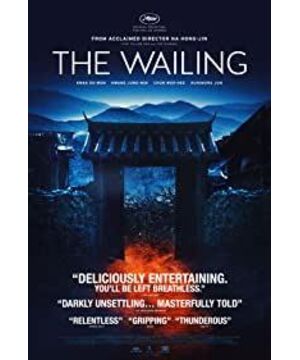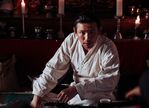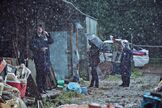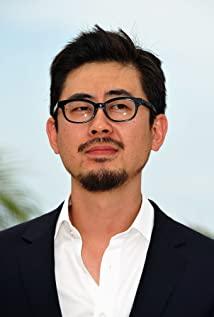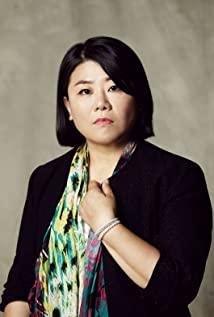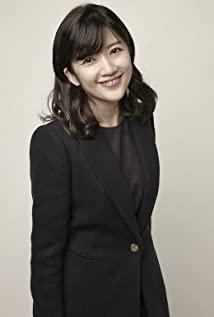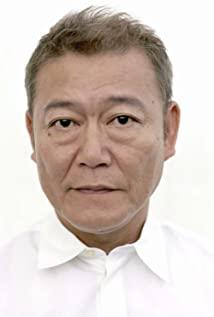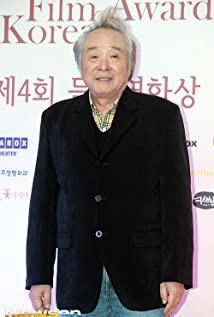I saw a lot of comments saying that the director had collapsed; the hole dug could not be filled; I don't agree. Although this film cannot be called a masterpiece, and its level has not surpassed the previous "Yellow Sea", its completion is still good. Although there are some doubts that confuse the audience, the director has left clues in the dark to remind them. (In the following plot analysis, the reader will answer them one by one).
Topic Analysis
The title of the film is crying. In fact, it has already been named as a tragedy. The core of its tragedy still cannot escape the most typical fate and impermanence in ancient Greek tragedy.
The tragedy of tragedy lies in the fact that the audience, from the perspective of an omniscient God, watches the people in the play either unknowingly be manipulated by fate and then go unfortunate, or they try their best to get rid of fate but in vain. If we go deeper, it is probably that the director wants to use the way of movies to ask the meaning of the world.
Someone in the family passed away before. It was a sudden departure when he shouldn't have died. At that time, I had just finished filming "The Yellow Sea", and my heart was a little twisted. I always wondered why this happened. Is there any other reason? I can't believe that such a kind person has died. So after returning from the funeral, I started looking for the reason, and then I thought of making such a story.
The script of "The Crying" took about two years, 7 revisions, six months for scene selection, six months for shooting, and more than a year for post-production. When writing the script, Luo Hongzhen felt very difficult about the part related to "God", and he made a special trip to visit many clergymen to seek answers from them. In order to get more diverse answers, he also traveled as far as Nepal, Japan and other places.
The film has a strong religious color. From the very beginning, the New Testament "Luke Gospel" uses the dialogue between Jesus and his disciples who suspect that he is a ghost after the crucifixion and resurrection. , and coincides with the 8 days of Good Friday (also known as Holy Week) in Christianity, implying that it is a crucifixion story. The director himself has also admitted that the genre of the film is more appropriate to Occult than suspense, and he has the intention of making a Korean-style "Omen" or "The Exorcist".
The film mainly tells about a disaster that happened to Zhong Jiu's family and their village for no reason, and how the protagonist Zhong Jiu coped with this disaster. The story in the Old Testament "Job" is very similar, or the director just wanted to. To make a modern version of the Book of Job.
The Book of Beyonce tells the story:
In ancient Israel, there was a man named Job, who was upright in character, feared God, did not do evil, and had a wealthy family. He had seven sons and three daughters. One day, Job suffered a sudden calamity: part of his livestock was taken into captivity, part of his livestock was burned to death by the fire of heaven, and the servants who followed were also killed. Job suddenly lost all his possessions. A more terrifying tragedy ensued. Job's children were eating together, and suddenly the house was blown down by the strong wind, and all of Job's children were crushed to death. In the end, Job himself suddenly fell ill and lost his health. He "swelled with sores from the soles of his feet to the top of his head"; "Job sat in the ashes and scratched his body with tiles."
Job's spirit was extremely painful. He reflected on his life and asked God the following questions: Why me? what did I do? Why suffer the injustice of fate?
In fact, the beginning of the story of "Job" has already revealed the truth behind the scenes: Job's suffering is related to God's arrangement. Satan believed that Job's trust in God was entirely due to his personal happiness, or that Job had a request from God. But God didn't believe Satan's words, and decided to test Job's faith, so he acquiesced to Satan's suffering for Job. Of course, this is a behind-the-scenes story that the owner, Uncle, doesn't know.
The story continues with a conversation between three "friends". In order to comfort Job, the three friends talked about their own views. Their common opinion was that the reason Job suffered was because Job sinned; in other words, the tragedy of the family was caused by Job's sin.
Job firmly disagreed with the three friends. Job told them that he was righteous and upright, and that he had no "sin" and that he suffered innocently.
Job had always wanted to be able to talk to God, and he wanted to know the reason for his suffering, but God did not directly answer Job's question, but rebuked Job, saying that Job slandered his reputation: Will you reject what I have planned? Shall I be condemned? Do you want to be righteous?
Because Job's thinking logic is as follows: Job believes that the disaster of his family's ruin was not caused by his own or his children's great sins, but Job also believes that God's justice is manifested in the fact that good is rewarded with good, and evil is repaid. There is evil reward; but looking at the world from the reality of his own experience and from his own experience, he found that it is quite common that evil people do not get evil rewards, but everything goes well; while many good people get evil rewards, including himself; this kind of He couldn't explain the phenomenon, and his reasoning was that God was not as righteous as he thought. In this way, Job puts himself above God, and he thinks that his righteousness is a little better than God's righteousness.
Finally, Job confessed his sins and repented before God. The sin Job confessed here was his ignorant comments on God.
If "Boyoe" is a game between God and Satan in the human world, in the film "The Cry", there are also the old Japanese man played by Hayabusa Kunimura and the woman in white played by Qian Yuxi. Two supernatural images that cannot be explained by common sense, while the plot of the film unfolds, the audience can't help but start their own speculation; in the end, who is the good or the evil, the god or the devil, the old Japanese man and the woman in white?
In fact, at this time, the audience has unknowingly bit the bait arranged by the director.
In the Old Testament "Genesis", God warned Adam and Eve that they could enjoy everything in the Garden of Eden, but the fruit from the tree of knowledge of good and evil could not be eaten, and if they ate it, they would surely die. But Adam and Eve ate the forbidden fruit under the temptation of the snake, were punished by God and were expelled from the Garden of Eden, and began to live with sin.
Original sin (original sin), the earliest sin, this is the first sin of human beings in the Bible, and it is also the most fundamental sin: not listening to God's words, eating the fruit of discernment between good and evil that God forbids people to eat, and then have self-righteousness and evil I began to doubt and disbelieve in God, began to judge right and wrong based on whether it was in line with myself, and acted according to my own likes and dislikes.
Since then, the whole world knows that beauty is beauty, and it is evil. Everyone knows that good is good, and that is not good. - "Tao Te Ching"
In the film, the protagonist once went to the church to ask the priest whether the Japanese were ghosts or not. The priest always remained neutral, only emphasizing that seeing is believing, not believing things without evidence, and warned the protagonist not to be superstitious (the subtitle I read was mistranslated as asking for the protagonist believe in wizards).
to be continued
The final scene of the video:
Plot analysis: use hidden clues reasoning to restore the "truth" of the case
As the third feature film directed by Luo Hongzhen, like the previous works "The Chaser" and "The Yellow Sea", it is still a thrilling and suspenseful way. As early as in the film "The Yellow Sea", Luo Hongzhen once left blanks, and some suspense was not directly answered to the audience (why did President Jin and Section Chief Jin want to kill Professor Jin), but at the same time he left obscure indirect clues to let the audience. The audience is left to reason and interpret on their own. And in this "Cry", Luo Dao Gu's ability to cast doubts is even more powerful. The film is full of bizarre mysteries from beginning to end, which makes many audiences see a question mark.
Not long ago, I watched another suspenseful movie "The Lighthouse". Compared with "The Crying", I felt more and more that Director Luo was actually kind. At least he left a lot of substantive clues in his films. Not an ethereal symbol.
Here's the time to look for clues and reason.
First spit out a certain version of Chinese subtitles
This version of the subtitles should be the earliest and most widely circulated. I feel that the subtitles may have been translated by listening to the work without the Korean version of the subtitles, and some parts that are really unclear are combined with the plot or context.” "Free translation" came out, resulting in a lot of loopholes. Among them, there are the following points that will affect the audience's misunderstanding of the plot:
This mistranslation led many viewers to mistakenly believe that the woman who hanged herself was not committed suicide, but was hanged on the branch after being repaired by others. Why this is important will be used later in the reasoning.
This mistranslation caused many viewers to mistakenly believe that the woman in white played by Qian Yuxi wanted to enter Xiaozhen's room to harm people. In fact, it was a man who was frightening people outside the door, and the biggest suspect was the Japanese played by Hayabusa Kunimura.
Is the old Japanese man doing evil?
There are many rumors about the Japanese in the village. Some hunters say they eat raw animals, and others say they rape women.
Let's take a look at the flashback of the film about Japanese rape of women.
The audience will probably think that these pictures are just imaginary when a third party relays the rumors, and it may not actually happen.
Well, the director also has this intention, so that the audience only suspects the Japanese, but cannot judge.
But in the dark, the director deliberately left clues that could actually hammer the crimes of the Japanese, and in order not to let the audience miss it, he also left two places.
In these two photos, the hanged woman is wearing the same dress as in the flashback and holding the same paper cup as the Japanese in the flashback.
This all proves that what happened in the flashback scene is real.
The process reasoning is as follows.
While having a picnic by the river with a group of friends, a woman met an old Japanese man who came to the river for wild fishing. After chatting with everyone for a while and taking pictures of the woman, the Japanese went fishing alone on the rocky beach. The woman was attracted by the previous chat topic of the Japanese, and took the initiative to bring the wine and food to the old man to share and continue to chat with the wine. During this period, the Japanese physically molested the woman without warning. The woman was frightened, and Japan turned her face and violently.
Why is it said that the woman took the initiative to chat with the Japanese, because the food on the rocky beach is obviously not for one person, and there is no account in the film that the Japanese have a car, and go out to fish alone with so many guys carrying pots and pans It is also not logical to start a gang, so the most reasonable explanation is that these foods were prepared by a group of women (there was cooking smoke in the crowd in the distance), and they were brought over by the women and shared with the Japanese. This is also in line with the theme that the fish in the film are actively biting their hooks.
Another supporting evidence is that when Zhong Jiu's colleague found Xiaozhen's shoes in the secret room, there were women's underwear next to it. It is very likely that the Japanese took off the hanged woman after the violence and used it to cast a spell. The cross suggests that the apostle will also be the victim later.
Why didn't people not far away stop the Japanese from committing violence?
Apart from the possibility of the Japanese covering the woman's mouth to prevent her from making a sound or being stunned directly, it can be seen from the shock of Zhong Jiu and his wife in their car parked on the side of the road during the day, the folk customs of this remote village in Korea can be seen. In fact, it is relatively open. Even if a female friend sees any clues, since the woman took the initiative to approach the man, they will probably think that this is a matter of mutual affection, and it is not easy to break it.
Why didn't the woman call the police after the incident?
This can be explained to a certain extent from Zhong Jiu's own experience. He found his daughter's shoes in the Japanese, and when he secretly flipped through his daughter's notebook, he saw the following graffiti:
Wouldn't he have any associations after working as a criminal police officer for half his life?
As a policeman, this is the case, which shows how weak the legal concept here is.
Did the wizard daylight do evil?
As can be seen from the above, many of the photos of the sun box were taken by Japanese. In addition, Nikko also wears a Japanese-style loincloth, so it is not difficult to see that the Japanese and Nikko know each other.
Is it just that simple to know?
Screenshot of Nikko's exorcism at Zhongjiu's house:
This pillar actually has a backing. It is called Changcheng, which is a folk belief in Korea.
"Changcheng", as the "guardian" of the village, is worshipped by people in hopes of eliminating disasters and warding off evil spirits, and is also used to mark the mileage between villages. The flag pole stands in front of the village together with Changcheng, hoping to symbolize its vertical structure as a passageway for the unity of heaven, earth and man, in order to pray for the peace, repair and harvest of the village. Changcheng is a kind of art, and it is sacred as a protector. The maker must be sincere when making it. One month before the production, he must take a bath and fast, and he cannot eat meat or go to mourning homes. After it is done, sacrifices must be held. Activity.
Changcheng can't really fight with the Japanese. If this Changcheng is an incarnation of evil spirits, it may have been in the village for hundreds of years, and cursed the village for hundreds of years. Gou to now, it is a miracle.
The reasonable explanation for Nikko's doing this is that he is weakening the power of the village's patron saint, and the consequence of this is nothing more than that the curse of evil spirits will be more rampant, which is also the purpose of Nikko's method.
What would happen if Zhongjiu didn't block the sunlight and let the French run smoothly? In fact, the director also gave a hint in the film.
When the French style is about to be completed, it is the moment when the evil person completely enters the devil and starts to kill.
The first case: the case of the Zhao family
However, there was no wizard at the scene of the murder, and there were also episodes where no wizard called the police (no matter how weak the legal concept is, it is not enough to witness the murder and not call the police). It can be speculated that the wizard who did it is not someone else, but Nikki himself, who knows the inside story.
The second case: the case of arson and hanging (there are survivors, the evil ones hang themselves)
No evidence of witches' involvement
The third case: Park Chunpei case (no survivors, the evil ones are like zombies)
The fourth case: Xiaozhen case (there are survivors, and the evil one is in a state of being lost after the murder)
Of the four cases shown in the film, the best ending should be the second case. Without the intervention of sunlight, there are not only survivors, but the evil ones will hang themselves after killing them, indicating that there is still a sense of guilt, consciousness is still there, or The soul lives on after death.
The worst ending is undoubtedly the third one. It is suspected that Nikko's French style has been completed, there are no survivors, and the evil man Park Chunpei is like a zombie after killing, or a killing machine that has lost its own soul and has been injected with evil spirits.
It is not difficult to see that the method of Sunlight is the process of taking off the protective clothing of the evil person and pushing him into the sea of viruses. The guardian mana of the village god is also very limited, which can delay the outbreak of the virus to a certain extent. In the end, it can only guarantee the immortality of the soul but not the physical body.
The identity of the Japanese old man
The film clearly shows that there is a history of Japanese militarism's religious oppression or belief monopoly on the Korean Peninsula during the Japanese occupation period, although the director has been evasive when answering this question in the interview, for fear of hurting the feelings of the Japanese audience?
As a counselor, it is naturally impossible to portray the role played by Kunimura Falcon as a true Shinto believer, otherwise too many people will be offended. After all, Shinto was once the state religion of others.
So Luo Dao took a little thought and turned his head.
I switched to a religious belief that is also a Japanese specialty, but very small, and originally had a bit of an evil color - Shugendo (well, there are fewer people offended this time)
Shugendo is a complex religion that originated from the Tantric Buddhism, but also incorporates the characteristics of Shintoism, and is also closely related to Taoism. They worship Bodhisattva and believe in Japanese gods. They are like monks and often hang out in shrines. The method of practice does not deviate from one sect and one sect and is widely used in all sects, so it is named "Dao".
Shugendo respects the master of Kukai who once traveled eastward to the Tang Dynasty (who founded the Eastern Secret Mantra) as the ancestor, and Xiaojiao (the legendary first immortal in Japan, who can subdue and exorcise demons) as the founder of the mountain, two special occupations of Onmyoji and Ninja. It is said that they all evolved from Shugendo.
Shugendo values physical practice more than doctrinal research. Believers have to practice in a very harsh environment deep in the mountains, so they are also on the mountain.
This is also in line with the background of the Japanese living in the deep mountains in the film. The Japanese cleanse themselves under the waterfall is also a unique way of ascetic practice of Shugendo, which is called "scale-off".
Masks found in Japanese residences, some people say that it is the mask of Amaterasu, is actually not correct. This is a common female face (onna mask) in Noh music (an opera dance that was first used to please the gods in sacrifices). below), but this mask itself has no symbolic meaning of a specific god, and only when it appears in a specific repertoire and a specific character will it be given a specific symbol.
Shugendo practitioners already have the custom of offering sacrifices to dance music. The Kagura of early shrines and the folk music of Tiangaku were influenced by Shugendo, so it is reasonable to have a female face here.
Two books were also found in the Japanese residence, one is the famous Erotica atlas "The Forty-Eight Hands of Edo", and the other is a collection of bird photography.
Tantric Buddhism has always had the theory of double cultivation, and Shugendo, as a branch of Tantric Buddhism, has been affected more or less, so "Edo Forty-Eight Hands" does not seem abrupt. As for the bird photo album and the vision of crows lingering near the Japanese residence, it is actually a clue.
So the identity of the Japanese is a Shugendo Master?
In fact, there is a widely circulated legend about the Yamabushi of Shugendo, and that is the tengu.
It is said that after the death of monks who did not practice enough to give up their attachments and delusions, they were saved from falling into the four realms of hell, hungry ghosts, asuras, and animals because of their Buddha nature. Banished to the tengu way outside the six realms of reincarnation, it became an existence that hinders the Dharma. This is very similar to the Western religion's claim that demons are fallen angels.
The image of Tengu also overlaps with Yamabushi to a certain extent - dressed in Shugendo practitioner clothes, holding a vajra staff or a sword, a feather fan, wearing single-toothed high clogs, and arrogant and talented by nature.
There are many stories about Tengu in the "Stories of the Past and Present" in the Heian period. For example, in the third episode "Tengu transforming into a Buddha in the treetops", Tengu disguised as Guanyin and appeared on a large persimmon tree by the road to attract people. Worship; in the fifth item "Renhe Temple is a monk who is meeting a nun tengu", the tengu incarnates as a nun and wants to snatch the eminent monk's trunk; in the sixth item "Buddha's Eye Temple Renzhao Ajali monk's house is visited by a woman possessed by a tengu", the tengu incarnates as a nun Possessing a woman seduces a monk.
To sum up, Tengu likes to interact with humans and is a kind of monster that is actively active in the human life circle. From the capital city to the remote villages, from the nobles of the imperial palace to the common people, from the esteemed monks to the unknown monks, they have all dealt with tengu. Tengu not only harassed human beings directly, but also taught magic to warlocks, and openly rebelled against Buddhism in order to be worshipped and respected by human beings.
to be continued
View more about The Wailing reviews


